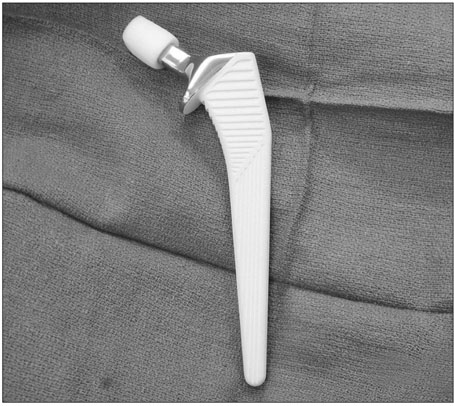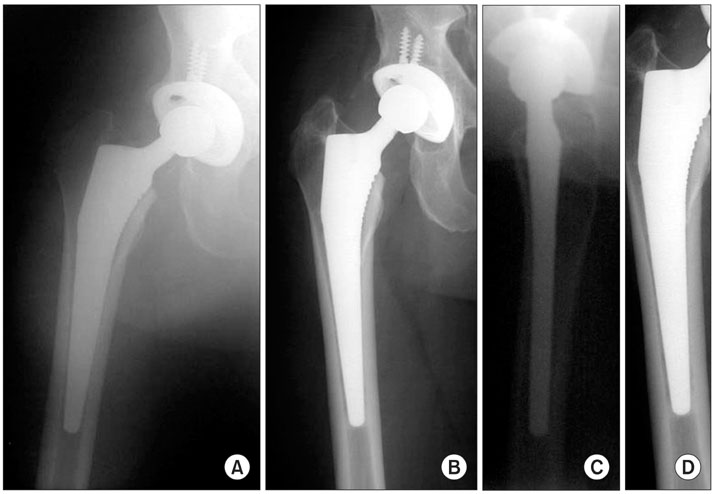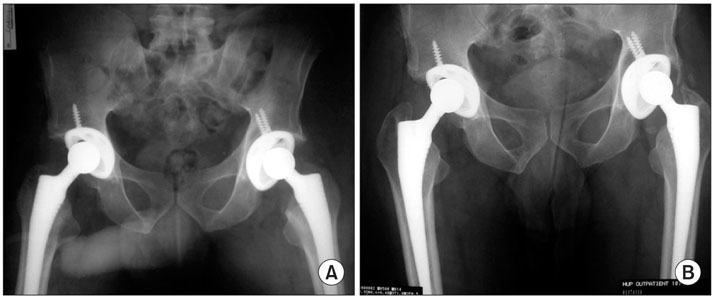Clin Orthop Surg.
2010 Dec;2(4):214-220. 10.4055/cios.2010.2.4.214.
Seven-year Results of a Tapered, Titanium, Hydroxyapatite-Coated Cementless Femoral Stem in Primary Total Hip Arthroplasty
- Affiliations
-
- 1Department of Orthopaedic Surgery, Ilsan Paik Hospital, Inje University College of Medicine, Goyang, Korea.
- 2Department of Orthopaedic Surgery, Presbyterian Medical Center, University of Pennsylvania, Philadelphia, PA, USA. Jonathan.Garino@uphs.upenn.edu
- 3Department of Orthopaedic Surgery, Kangwon National University Hospital, Chuncheon, Korea.
- KMID: 1719321
- DOI: http://doi.org/10.4055/cios.2010.2.4.214
Abstract
- BACKGROUND
Aseptic loosening of cemented hip prostheses is recognized as a long-term problem, and especially in males and younger patients. Much energy has been focused on developing new prostheses that are designed for cementless fixation. We evaluated the performance of and periprosthetic bone response to a tapered, titanium, hydroxyapatite (HA)-coated femoral hip prosthesis at a minimum of 7 years of follow-up after treatment with primary total hip arthroplasty.
METHODS
Seventy-eight patients and 86 hips were included in the study. There were 35 men and 43 women; the mean age at the time of the operation was 59 years (range, 41 to 81 years). We used a tapered, titanium (Ti6Al4V), HA-coated femoral implant. We evaluated the patients at a minimum of 7 years of follow-up after treatment with primary total hip arthroplasty. Clinical evaluation was performed using the scoring system and the hip scores were assigned according to the level of pain, the functional status and the range of motion. The patients who refused to return, but who did forward X-rays for review after being contacted were questioned by phone about the functional status of their hip. Radiographic follow-up was performed at six weeks, at three, six and twelve months and yearly thereafter. All the available radiographs were collected and assessed for implant stability, subsidence, osseointegration, osteolysis, stress shielding and evidence of periprosthetic lucency.
RESULTS
Eighty-six hips (78 patients) were available for review at follow-up of greater than 7 years. In 11 of the 86 cases, acetabular failure required revision of the acetabular component, but the femoral stem survived and it was available for long-term evaluation. The radiographs were obtained at 7-year follow-up for another 20 hips, but the patients would not come in for the 7-year clinical evaluation. Therefore, a phone interview was conducted to assess any change in the functional status at a minimum of 7 years.
CONCLUSIONS
The mechanical fixation of a tapered, titanium, HA-coated femoral implant was excellent in this study. This femoral design provided reliable osseointegration that was durable at a mean of 7 years follow-up.
MeSH Terms
Figure
Reference
-
1. Johnsson R, Franzen H, Nilsson LT. Combined survivorship and multivariate analyses of revisions in 799 hip prostheses: a 10- to 20-year review of mechanical loosening. J Bone Joint Surg Br. 1994. 76(3):439–443.
Article2. Callaghan JJ, Forest EE, Sporer SM, Goetz DD, Johnston RC. Total hip arthroplasty in the young adult. Clin Orthop Relat Res. 1997. (344):257–262.
Article3. Sochart DH, Porter ML. The long-term results of Charnley low-friction arthroplasty in young patients who have congenital dislocation, degenerative osteoarthrosis, or rheumatoid arthritis. J Bone Joint Surg Am. 1997. 79(11):1599–1617.
Article4. Soballe K, Hansen ES, B-Rasmussen H, Jorgensen PH, Bunger C. Tissue ingrowth into titanium and hydroxyapatite-coated implants during stable and unstable mechanical conditions. J Orthop Res. 1992. 10(2):285–299.
Article5. Kroon PO, Freeman MA. Hydroxyapatite coating of hip prostheses: effect on migration into the femur. J Bone Joint Surg Br. 1992. 74(4):518–522.
Article6. Teloken MA, Bissett G, Hozack WJ, Sharkey PF, Rothman RH. Ten to fifteen-year follow-up after total hip arthroplasty with a tapered cobalt-chromium femoral component (trilock) inserted without cement. J Bone Joint Surg Am. 2002. 84(12):2140–2144.
Article7. Purtill JJ, Rothman RH, Hozack WJ, Sharkey PF. Total hip arthroplasty using two different cementless tapered stems. Clin Orthop Relat Res. 2001. (393):121–127.
Article8. Charnley J. The long-term results of low-friction arthroplasty of the hip performed as a primary intervention. J Bone Joint Surg Br. 1972. 54(1):61–76.
Article9. D'Aubigne RM, Postel M. Functional results of hip arthroplasty with acrylic prosthesis. J Bone Joint Surg Am. 1954. 36(3):451–475.10. Gruen TA, McNeice GM, Amstutz HC. "Modes of failure" of cemented stem-type femoral components: a radiographic analysis of loosening. Clin Orthop Relat Res. 1979. (141):17–27.11. Johnston RC, Fitzgerald RH Jr, Harris WH, Poss R, Muller ME, Sledge CB. Clinical and radiographic evaluation of total hip replacement: a standard system of terminology for reporting results. J Bone Joint Surg Am. 1990. 72(2):161–168.
Article12. Havelin LI, Espehaug B, Vollset SE, Engesaeter LB. Early aseptic loosening of uncemented femoral components in primary total hip replacement: a review based on the Norwegian Arthroplasty Register. J Bone Joint Surg Br. 1995. 77(1):11–17.
Article13. Rokkum M, Reigstad A. Total hip replacement with an entirely hydroxyapatite-coated prosthesis: 5 years' follow-up of 94 consecutive hips. J Arthroplasty. 1999. 14(6):689–700.14. Reikeras O, Gunderson RB. Excellent results of HA coating on a grit-blasted stem: 245 patients followed for 8-12 years. Acta Orthop Scand. 2003. 74(2):140–145.
Article15. Stephenson PK, Freeman MA, Revell PA, Germain J, Tuke M, Pirie CJ. The effect of hydroxyapatite coating on ingrowth of bone into cavities in an implant. J Arthroplasty. 1991. 6(1):51–58.
Article16. Yee AJ, Kreder HK, Bookman I, Davey JR. A randomized trial of hydroxyapatite coated prostheses in total hip arthroplasty. Clin Orthop Relat Res. 1999. (366):120–132.
Article17. Donnelly WJ, Kobayashi A, Freeman MA, et al. Radiological and survival comparison of four methods of fixation of a proximal femoral stem. J Bone Joint Surg Br. 1997. 79(3):351–360.
Article18. Tanzer M, Kantor S, Rosenthall L, Bobyn JD. Femoral remodeling after porous-coated total hip arthroplasty with and without hydroxyapatite-tricalcium phosphate coating: a prospective randomized trial. J Arthroplasty. 2001. 16(5):552–558.
Article19. McLaughlin JR, Lee KR. Total hip arthroplasty with an uncemented femoral component: excellent results at ten-year follow-up. J Bone Joint Surg Br. 1997. 79(6):900–907.20. McNally SA, Shepperd JA, Mann CV, Walczak JP. The results at nine to twelve years of the use of a hydroxyapatite-coated femoral stem. J Bone Joint Surg Br. 2000. 82(3):378–382.
Article21. Skinner JA, Kroon PO, Todo S, Scott G. A femoral component with proximal HA coating: an analysis of survival and fixation at up to ten years. J Bone Joint Surg Br. 2003. 85(3):366–370.22. D'Antonio JA, Capello WN, Manley MT, Geesink R. Hydroxyapatite femoral stems for total hip arthroplasty: 10- to 13-year followup. Clin Orthop Relat Res. 2001. (393):101–111.23. Mallory TH, Lombardi AV Jr, Leith JR, et al. Minimal 10-year results of a tapered cementless femoral component in total hip arthroplasty. J Arthroplasty. 2001. 16:8 Suppl 1. 49–54.
Article24. Engh CA, Massin P, Suthers KE. Roentgenographic assessment of the biologic fixation of porous-surfaced femoral components. Clin Orthop Relat Res. 1990. (257):107–128.
Article25. D'Antonio JA, Capello WN, Jaffe WL. Hydroxylapatite-coated hip implants: multicenter three-year clinical and roentgenographic results. Clin Orthop Relat Res. 1992. (285):102–115.26. D'Antonio JA, Capello WN, Crothers OD, Jaffe WL, Manley MT. Early clinical experience with hydroxyapatite-coated femoral implants. J Bone Joint Surg Am. 1992. 74(7):995–1008.27. Tonino AJ, Rahmy AI. The International ABG Study Group. The hydroxyapatite-ABG hip system: 5- to 7-year results from an international multicentre study. J Arthroplasty. 2000. 15(3):274–282.28. Pidhorz LE, Urban RM, Jacobs JJ, Sumner DR, Galante JO. A quantitative study of bone and soft tissues in cementless porous-coated acetabular components retrieved at autopsy. J Arthroplasty. 1993. 8(2):213–225.
Article
- Full Text Links
- Actions
-
Cited
- CITED
-
- Close
- Share
- Similar articles
-
- Short-term Results after Cementless Total Hip Arthroplasty Using a Fully Hydroxyapatite-coated Femoral Stem
- Short Term Results of Cementless Total Hip Arthroplasty With a Tapered Femoral Component
- Radiological Analysis of the Tapered Femoral Stem after Cementless Hip Arthroplasty: Minimum 5 years follow-up
- Cementless Total Hip Arthroplasty Using Hydroxyapatite-Coated Femoral stem. - Two-Year Clinical and Radiologic Follow-UP-
- Mid-term Results of Primary Cementless Total Hip Arthroplasty with a Fiber Metal Taper Femoral Component and Trilogy Acetabular Cup




